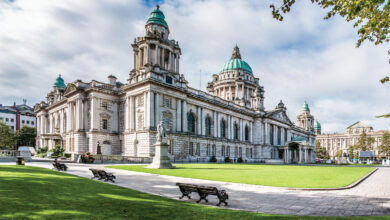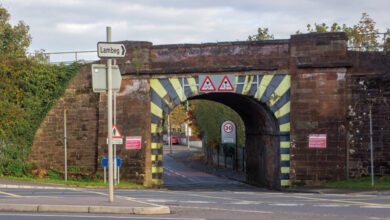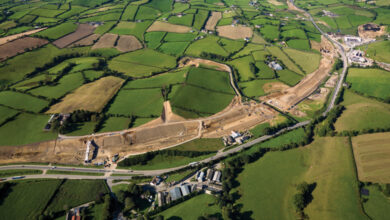Better spaces for Belfast
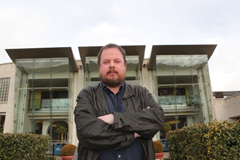 Thinking outside the box can save the city’s remaining terraces and regenerate its wasted open spaces, architect Mark Hackett tells Peter Cheney.
Thinking outside the box can save the city’s remaining terraces and regenerate its wasted open spaces, architect Mark Hackett tells Peter Cheney.
Belfast’s original streets are disappearing and will soon be gone for good unless urgent action is taken, according to Mark Hackett. “I think we have very little time to save what is unique about Belfast’s spaces,” the architect states.
Most of the old Victorian terraces and mill buildings have been knocked down, taking with them much of the city’s character. Some of the best remaining examples can be found in the Village and the New Lodge.
Hackett is a Co-Director of the Forum for Alternative Belfast, a non-profit “think tank and do tank” aiming for “a connected and a better designed city”.
As well as being more sensitive to the past, he wants to see more strategic thinking about how today’s streets are used. This follows on from the ‘Happy to live here?’ exhibition on urban design organised by him and fellow architect Declan Hill in 2006.
“What was realised was that it wasn’t so much the housing, as the spaces in between housing, that was the biggest problem,” he comments. Car parking bays, for example, take up the space which could be used for a front garden.
No one organisation is in charge. The Roads Service, for example, maintains the street surface, its signs and lights, while the city council handles building standards and street names. A multiplicity of organisations “means it’s very difficult to pull together those forces to make good space.”
Decision-makers are also disconnected from local communities due to the Troubles and the legacy of direct rule. Hackett therefore sees a “renewed sense of local politics” as an important factor, with the people who make the decisions about an area actually coming from the area.
“What we need to talk about is care or pride in our area” whether than means the street or the city.
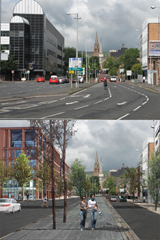 However, he claims that Belfast is not a single entity but three or four cities, with each one “not aware of the other”. The city centre “has become almost a utility for shopping, for business, but nobody lives there”.
However, he claims that Belfast is not a single entity but three or four cities, with each one “not aware of the other”. The city centre “has become almost a utility for shopping, for business, but nobody lives there”.
The solution, in his view, does not involve re-inventing the wheel but just adapting best practice from other places and implementing that with strong leadership. The English Partnerships quality standards, for example, were copied in Dublin’s regeneration.
At street level, strict enforcement of waste regulations would also improve appearances e.g. making sure that bins do not take up space at the front of houses. The new Social Development Minister will be asked by the forum to take a walk around two recent housing schemes, to point out examples of poor design.
While the city was once “completely walkable”, it has been given over to the car. Road-building from the 1960s onwards encircled the city centre with large open spaces. Hackett characterises Belfast city centre as a ‘grey doughnut’ encircled by those spaces, which could be put to good use with some creative thinking.
Take the Divis Street bridge over the Westlink, for example. The forum’s ‘Divis Pathfinder’ project visualises the street as an arterial route that can raise the value of surrounding buildings and encourage people to walk into the city centre. Shops could be built on the bridge itself.
Publicly-owned land could be released in a controlled way, thus making it a zero- cost improvement. This project is being assisted by the Strategic Investment Board and the Roads Service.
In addition, the forum’s ‘Inter-Change’ project considers how the Roads Service can complete the flyover at York Street originally planned in the 1960s. Traffic currently spills over into the nearby streets. The forum thinks that these streets could be used by more pedestrians and cyclists, with gardens, trees, shops and housing, again increasing the land value. A four-week exhibition on the project, using work by architecture post-grads, was held at the nearby Golden Thread Gallery during May.

